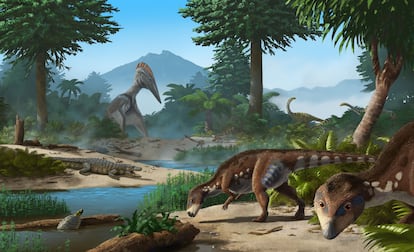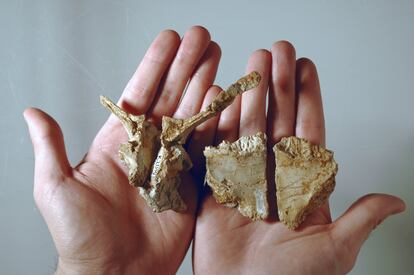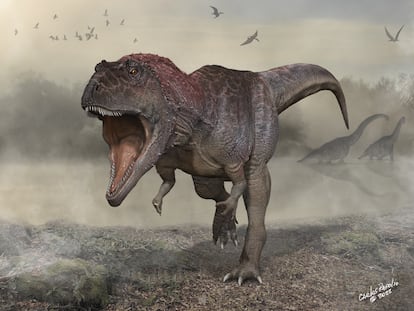Dwarf dinosaur that lived 70 million years ago discovered in Transylvania
The remains found shed new light on the state of the European fauna shortly before the extinction of the species

The legend of Dracula – inspired by a sadistic historical figure known as Vlad the Impaler – has a new, burly rival competing for attention in Transylvania: a dinosaur. An international team of paleontologists discovered a new species of dwarf dinosaur in the current territory of the Țara Hațegului International Geopark (Hațeg Country), located in the southwest of the Romanian region of Transylvania. This herbivorous dinosaur, named Transylvanosaurus platycephalus (which translates as “flat-headed Transylvanian reptile”), would have lived during the Cretaceous Period, more than 70 million years ago, as reported last week by the University of Bucharest. With up to 10 species of dinosaurs identified there in recent years, the Hațeg Basin has become an important epicenter of discoveries of vertebrates from the Late Cretaceous in Europe.
The bones, parts of the skull of the Transylvanosaurus, shed new light on the evolution of European fauna shortly before the extinction of the dinosaurs, 66 million years ago. This previously unknown species was approximately two meters long, walked on two legs and belonged to the family Rhabdodontidae. It had a small body, similar to other vertebrates discovered in this area, which are known as dwarf dinosaurs. “Presumably a limited supply of resources in these parts of Europe at that time led to an adapted small body size,” explains paleontologist Felix Augustin of the German University of Tübingen, lead author of the study. The discovery was recently published in the Journal of Vertebrate Paleontology.

Throughout most of the Cretaceous Period, which spanned from 145 to 66 million years ago, Europe was a tropical archipelago. The Transylvanosaurus lived on one of the many islands of that archipelago along with other dwarf dinosaurs, crocodiles, turtles and pterosaurs. “With each newly discovered species, we are disproving the widespread assumption that the Late Cretaceous fauna had a low diversity in Europe,” says Augustin. During the Late Cretaceous, the Rhabdodontidae was among the best represented group of small and medium-sized European herbivores. Related species found earlier in Hațeg, such as the Zalmoxes, had much less flattened skulls than the Transylvanosaurus.
Taxonomic identification was carried out from fossils measuring no more than 12 centimeters: the back of the skull, with the foramen magnum and the two frontal bones. “On the inside of the frontal bone it was even possible to discern the contours of the brain of Transylvanosaurus,” reveals paleontologist Dylan Bastiaans from the University of Zurich.
A team led by Zoltán Csiki-Sava, a professor at the faculty of geology of the University of Bucharest, discovered the skull bones of Transylvanosaurus platycephalus in 2007 in a riverbed of the Țara Hațegului region.
Island dwarfism
This discovery surprised the researchers because the closest relatives of the newly found dinosaur lived in what is now France, which raises the question: how did the Transylvanosaurus come to populate what is known as the Island of Dwarf Dinosaurs, which at the time covered the territory of Transylvania? According to the scientists, there are several possible explanations.
The oldest fossils attributed to the Rhabdodontidae group come from Eastern Europe. From there, the animals could have spread to the west, and later, certain species may have returned to the current territory of Țara Hațegului. The experts speculate that fluctuations in sea level and tectonic processes could have led to the creation of temporary land bridges between the different islands, which would have allowed the dinosaurs to move and spread to other places. It is even assumed that almost all dinosaurs, including the Transylvanosaurus, were able to swim to some degree. “They had powerful legs and a powerful tail. Most species, in particular reptiles, can swim from birth,” says Augustin. An alternative scenario suggests that certain groups of Rhabdodontidae developed in parallel in Eastern and Western Europe. However, the scientists remain unable to determine exactly how this species ended up in Transylvania. “We have currently too few data at hand to answer these questions,” Augustin explains.
The Transylvanosaurus fossils were able to survive for tens of millions of years protected by the sediments of an ancient river bed, until the waters of another, more recent river, took them back out. “If the dinosaur had died and simply lain on the ground instead of being partly buried, weather and scavengers would soon have destroyed all of its bones and we would never have learned about it,” says Agustín.









































